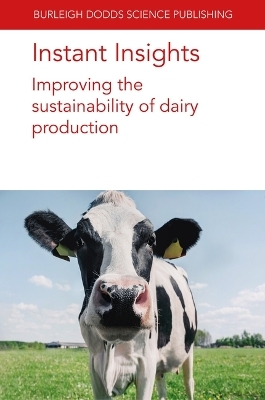
Instant Insights: Improving the Sustainability of Dairy Production
Burleigh Dodds Science Publishing Limited (Verlag)
978-1-80146-669-1 (ISBN)
This book features five peer-reviewed reviews on best practices for improving the sustainability of dairy production. The first chapter reviews the main, internationally accepted methods available to evaluate the environmental impact of dairy farming, identify levers of action and set environmental targets.
The second chapter considers how dairy farms can manage both energy consumption and water in order to minimise their environmental impacts. The chapter also addresses the issue of sustainable water use.
The third chapter provides a compilation of current research which highlights the need to further examine dietary mitigation strategies in ruminant production systems at a whole farm level. The chapter also discusses the range of nutritional strategies available for enteric- and manure-CH4 abatement.
The fourth chapter focusses on the role of the ruminant microbiome in methane emissions and the potential genetic factors affecting microbial composition and emission reduction.
The final chapter highlights the growing issue of food loss and waste (FLW) in countries with developed dairy value chains. The chapter discusses the key stages and management practices for reducing FLW in dairy value chains, as well as how decision-making can be improved.
Chapter 1 - Setting environmental targets for dairy farming: Sophie Bertrand, French Dairy Board (CNIEL), France;
1 Introduction
2 A global typology of dairy production systems for use in environmental assessments
3 Life cycle assessment (LCA): an overview
4 LCA: product carbon footprint
5 LCA: product water footprint
6 Assessing impacts on biodiversity
7 Setting environmental targets: challenges and limits
8 Conclusion
9 Where to look for further information
10 References
Chapter 2 - Improved energy and water management to minimize the environmental impact of dairy farming: J. Upton, E. Murphy and L. Shalloo, Teagasc, Ireland; M. Murphy, Cork Institute of Technology, Ireland; and I.J.M. De Boer and P.W.G. Groot Koerkamp, Wageningen University, The Netherlands;
1 Introduction
2 Understanding current energy use in dairy farming
3 Strategies to reduce energy use in dairy farming
4 Results, analysis and recommendations
5 Sustainable water use in dairy production
6 Conclusions: the relevance of energy reduction and water management strategies to dairy farm sustainability
7 Where to look for further information
8 References
Chapter 3 - Nutritional factors affecting greenhouse gas production from ruminants: implications for enteric and manure emissions: Stephanie A. Terry, Agriculture and Agri-Food Canada, Canada and University of Sydney, Australia; Carlos M. Romero, Agriculture and Agri-Food Canada and University of Lethbridge, Canada; and Alex V. Chaves and Tim A. McAllister, Agriculture and Agri-Food Canada, Canada;
1 Introduction
2 Case study: Dried distillers grains plus solubles (DDGS)
3 Nitro-based compounds
4 Plant secondary compounds
5 Carbon-derived materials
6 Microbial hydrogen utilisation
7 Future trends and conclusion
8 Where to look for further information
9 References
Chapter 4 - Host-rumen microbiome interactions and influences on feed conversion efficiency (FCE), methane production and other productivity traits: Elie Jami, Agricultural Research Organization – Volcani Center, Israel; and Itzhak Mizrahi, Ben-Gurion University of the Negev, Israel;
1 Introduction
2 Core community, resilience and natural variation in rumen microbiome composition
3 Microbiome-dependent traits
4 Methane production
5 Nitrogen compounds: utilization and emission
6 Microbiome and host genetics
7 References
Chapter 5 - Developing closed-loop dairy value chains and tools to support decision-makers: Jack B. Hetherington, University of Adelaide/CSIRO Agriculture and Food/Fight Food Waste Cooperative Research Centre, Australia; Pablo Juliano, CSIRO Agriculture and Food, Australia; and Rodolfo García-Flores, CSIRO Data61, Australia;
1 Introduction
2 Frameworks for identifying and managing food loss and waste in developed dairy chains
3 Key stages and management practices for reducing food loss and waste in dairy chains
4 Improving decision-making in managing food loss and waste in dairy value chains
5 Conclusion
6 Acknowledgements
7 Where to look for further information
8 References
| Erscheinungsdatum | 10.02.2024 |
|---|---|
| Reihe/Serie | Burleigh Dodds Science: Instant Insights ; 98 |
| Verlagsort | Cambridge |
| Sprache | englisch |
| Themenwelt | Technik ► Elektrotechnik / Energietechnik |
| Technik ► Umwelttechnik / Biotechnologie | |
| Weitere Fachgebiete ► Land- / Forstwirtschaft / Fischerei | |
| ISBN-10 | 1-80146-669-6 / 1801466696 |
| ISBN-13 | 978-1-80146-669-1 / 9781801466691 |
| Zustand | Neuware |
| Informationen gemäß Produktsicherheitsverordnung (GPSR) | |
| Haben Sie eine Frage zum Produkt? |
aus dem Bereich


